Texas Backyard Landscaping Ideas
Texas, with its diverse landscape, offers many ideas and motifs for yard design. The geographical diversity of the state is very noticeable and expressive, extending from the desert areas of West Texas to the wooded areas in the east, the hilly central region, and the coastal plains in the south. Each region offers unique species that you can incorporate into your yard design.
So, first of all, you should choose native plants specific to a particular state. Since we are talking about Texas, these plants have adapted to this state’s climate, which means they are straightforward to maintain – they withstand extremely dry periods well, there is no need for intensive irrigation and fertilization, and pests and lawn diseases do not occur.
Choosing native varieties is not only functional and ecologically justified but also aesthetically logical, as it creates a landscape that is pleasant and in harmony with the environment. Compared to other plant varieties, native ones create a resilient landscape requiring little effort and time.
West Texas has a desert climate and robust terrain, so plants that can withstand drought and high temperatures are ideal for yard design. These are landscapes that require little or no irrigation. In extremely dry areas, native Texas varieties such as Prickley Pear cacti, Agave, Yucca, Creosote Bush, Texas Sage, Texas Redbud, Mesquite, Desert Willow, Buffalo Grass, Rock Rose, Texas Mountain Laurel.
A variable climate characterizes North Texas, so choosing plants that can cope with frequent temperature changes is smart. Therefore, the most common choices are Texas Sage or Bluebells.
Central Texas skillfully combines the characteristics of the north and south, so the recommendation is to focus on very resistant plants that are easy to maintain, creating a mosaic of smartly chosen native varieties according to climatic conditions. Bluebonnet, Coral Honeysuckle, Lantana, Turks Cap, Red Bird of Paradise, Esperanza, Firecracker Fern, various Salvias, various flowering Sages, Agave, various Yuccas, Passion Vine are some of the specific varieties for this region.

South Texas has access to the Gulf of Mexico; considering this fact, palms, citrus, and other tropical plants fit very well. In addition, you will also find varieties such as Southern Sugar Maple and Yaupon Holly in South Texas.
In East Texas, there are wooded areas as well as open fields, so if you live in this region, you can combine plants that tolerate shade with tall trees.
Designing Functional Outdoor Spaces
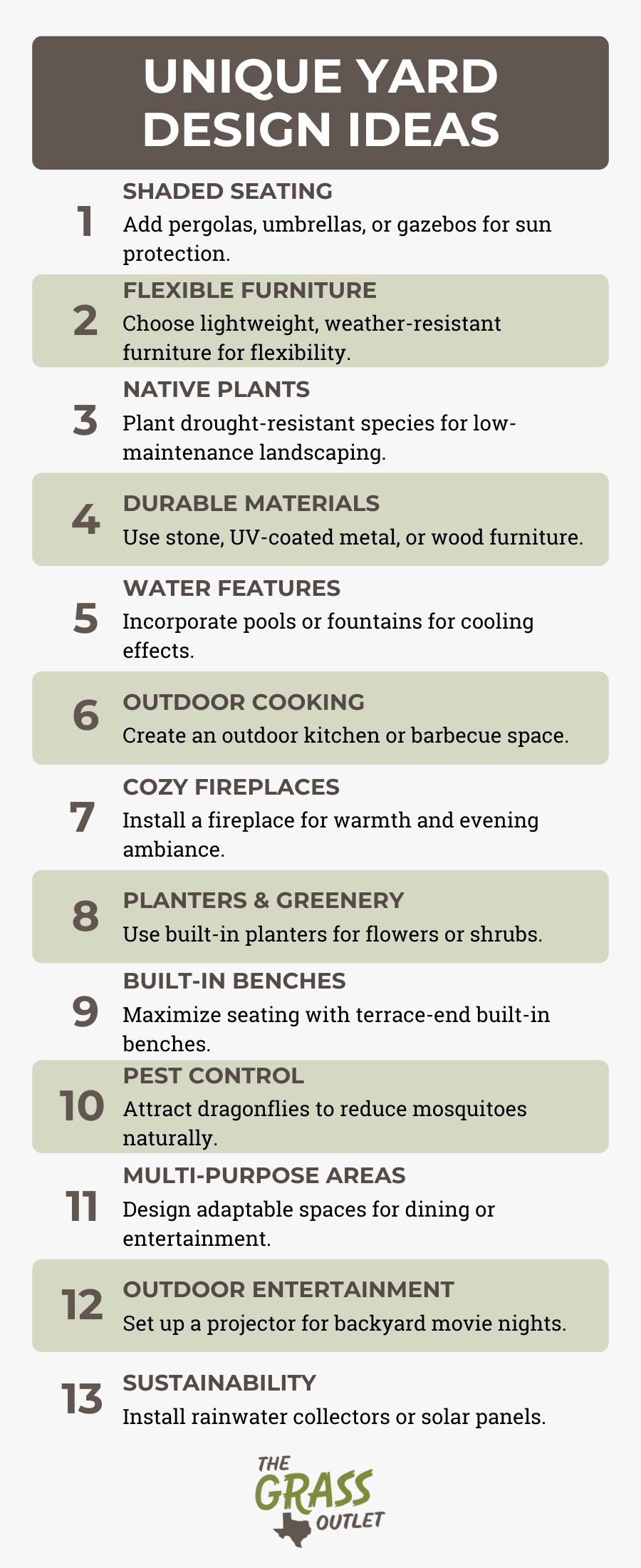
Just as the interior of your home requires dedication in its design, the same approach applies to your backyard and the entire outdoor space, which demands functional ideas, a clearly defined aesthetic, and rationally organized elements to enjoy it fully. The backyard should provide peace and relaxation after a busy day’s work or long work-week, and during the weekend, it is the ideal place for gathering family and friends.
The climate in Texas is such that for most of the year, you and your family can spend time comfortably outdoors, which alone is enough motivation to create your dream space. Here are some ideas to consider when making a unique yard:
- Shading your seating areas: consider pergolas, giant umbrellas, and even a gazebo. These can provide relief from the intense Texas sun while enriching the existing aesthetics.
- Comfortable and flexible furniture – There are many beautiful garden sets. Still, it is essential to choose adequate materials that are resistant to outdoor conditions. They should be lightweight fabrics so you can move them as needed.
- Native plants for planting that withstand drought and high temperatures will not require frequent watering and are easy to maintain.
- Durable and sun-resistant materials – you will often see stone in Texas yards because of the extreme heat, and metal and wooden furniture is coated with UV protection to preserve their lifespan.
- Water elements – pools and fountains – are fun, aesthetically very adaptable, and can provide coolness when it’s humid.
- Outdoor kitchen and barbecue – Texans like to gather friends and family by preparing gourmet specialties outdoors.
- The fireplace is beautiful in the evening, creating a warm, cozy atmosphere and a place to make s’mores with the kids.
- Integrated planters and greenery – You can fill built-in planters on the edges of terraces with flowers, herbs, or small shrubs, adding liveliness and character to the space through contrasting colors and textures.
- Built-in benches at the ends of terraces can save space and accommodate more guests.
- Mosquitoes and pest control – consider natural ways to keep the mosquitoes of your yard, such as ponds, bubblers, or fountains that attract and house dragonflies.
- Create points throughout the space that can be multi-purpose – a dining area in the evening can become a place for cocktails.
- Entertainment elements – installing a projector for an outdoor cinema.
- Sustainable ideas – collecting rainwater or solar panels on rooftops.
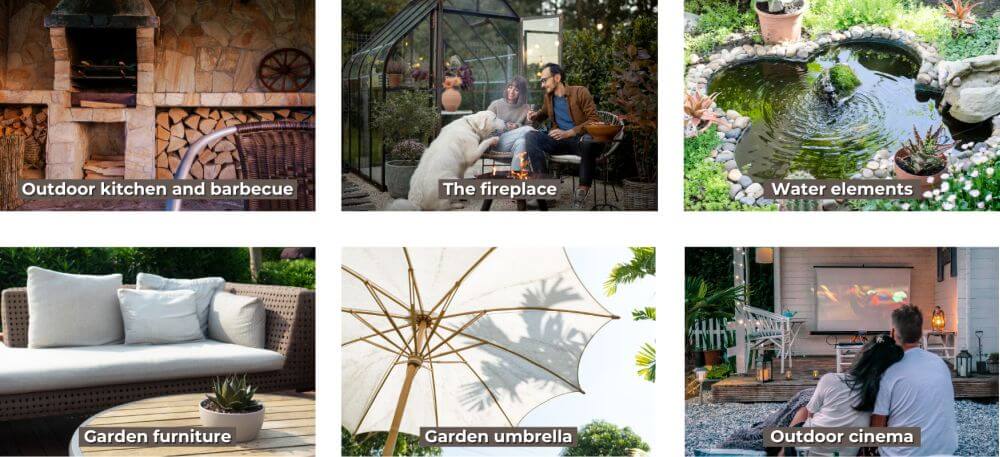
Depending on the size of the area, you can include many good ideas and create a space to fulfill the needs of everyone who lives there, both elders and children. Indeed, you will pay the most attention to the seating area, where the first-morning coffee is enjoyed, the family gathers for lunch, and in the evening, it becomes an ideal space for Texas barbeques and outdoor entertainment. You can remove the table and chairs and organize a casual dance scenario with a glass in hand, if necessary.
Creative Pathways and Walkways
Beyond being functional and practical, paths in a backyard also contribute a certain dynamic and vibrancy with their aesthetics. Forming and designing paths in the yard is an essential aspect of landscape design, as paths not only provide a practical way to move through the yard but also contribute to the aesthetics and functionality of the space.
Paths should be wide enough for comfortable walking and safe for all users, including children and older people. Also, the surface should be flat and stable, especially in pathways used frequently. The path design should fit into your yard’s overall style. Straight, symmetrical paths are suitable for formal gardens, common in residential properties. In contrast, curved, irregular paths are better for private and less formal gardens.
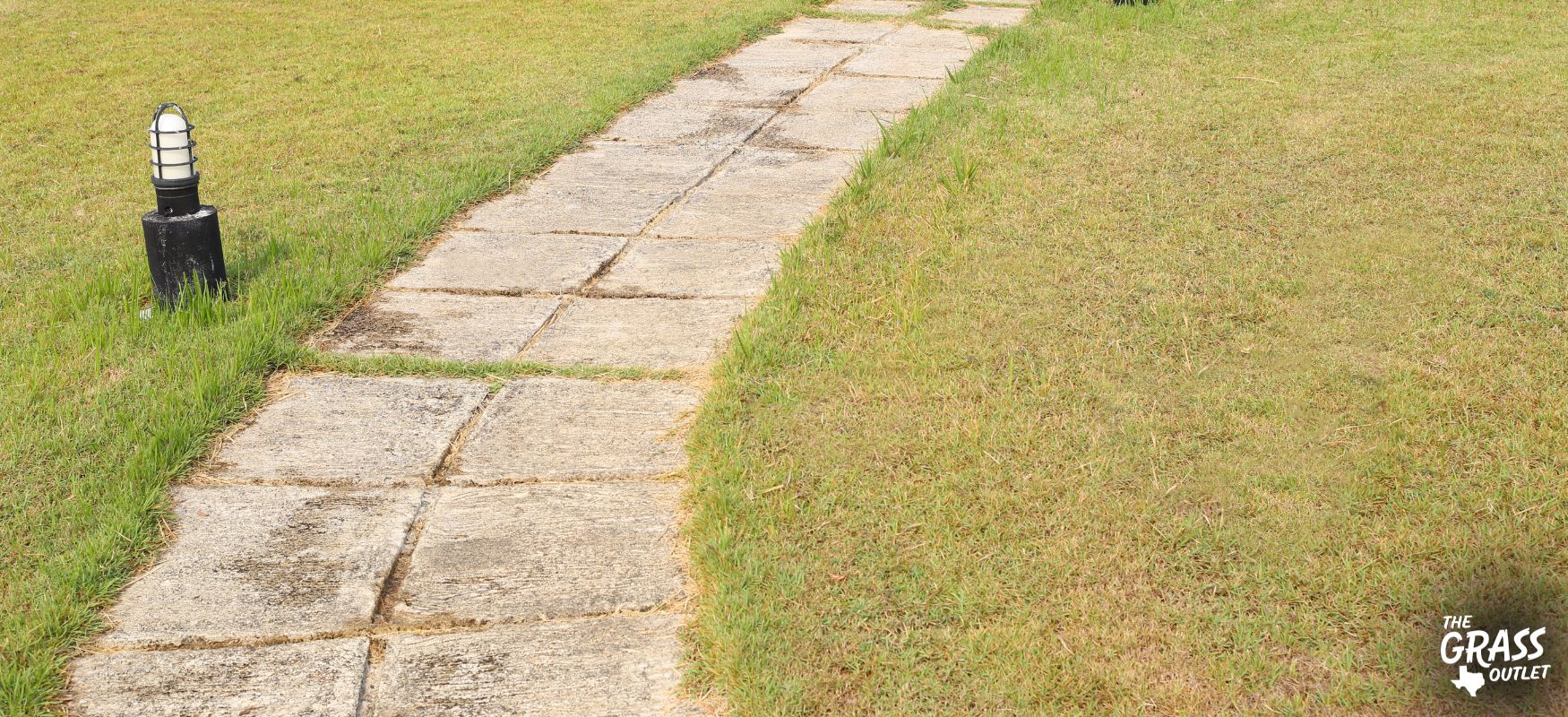
Curved paths can lead around plant elements and constructions such as ponds, flower beds, or sculptures, creating a dynamic and fluid path. Paths with large, irregularly shaped stone slabs further create a natural ambiance. The slabs can be set with gaps filled with grass or gravel.
Continuous concrete paths can be elegant and modern, especially in the case of smooth, straight lines. You can add colors or textures to the concrete for additional visual interest.
The Choice Of The Best Materials For Paths
It depends on several factors: climate, maintenance, aesthetic preferences, and functionality. Cobblestone is durable, varied in design, and requires little maintenance. It comes in different shapes, sizes, and colors. Proper installation with a good base and edging is key to prevent shifting or cracking.
Natural stone offers a unique and elegant look. Common choices include sandstone, slate, and limestone. It can be more expensive and requires a stable base. Irregular shapes may require some skill for installation. Brick brings a classic aesthetic. It is strong and can be laid in various patterns. It may require regular maintenance to manage moss or weeds between the bricks.
Gravel is affordable, easy to install, and allows excellent drainage. It can scatter outside the path area, therefore requiring the placement of edging to keep it in place. Composite decking is durable, requires little maintenance, and can mimic the look of wood. Still, it is more expensive than wood and can heat up in direct sunlight.
Healthy Lawn Tips
Maintaining a lush, healthy lawn in the Texas climate, which can range from semi-arid to humid and often experiences extreme temperatures, requires special care and practice.
Everything starts with wisely chosen grass species, and for Texas Native St. Augustine, Bermuda , Zoysia, and St. Augustine are suitable as they are drought-resistant and can withstand high temperatures.
Although the weather in Texas is warm throughout the year, it’s important not to overwater, as it can be just as damaging as under-watering. Water deeply but infrequently to encourage root growth. Watering early in the morning is best to reduce evaporation and fungal growth.
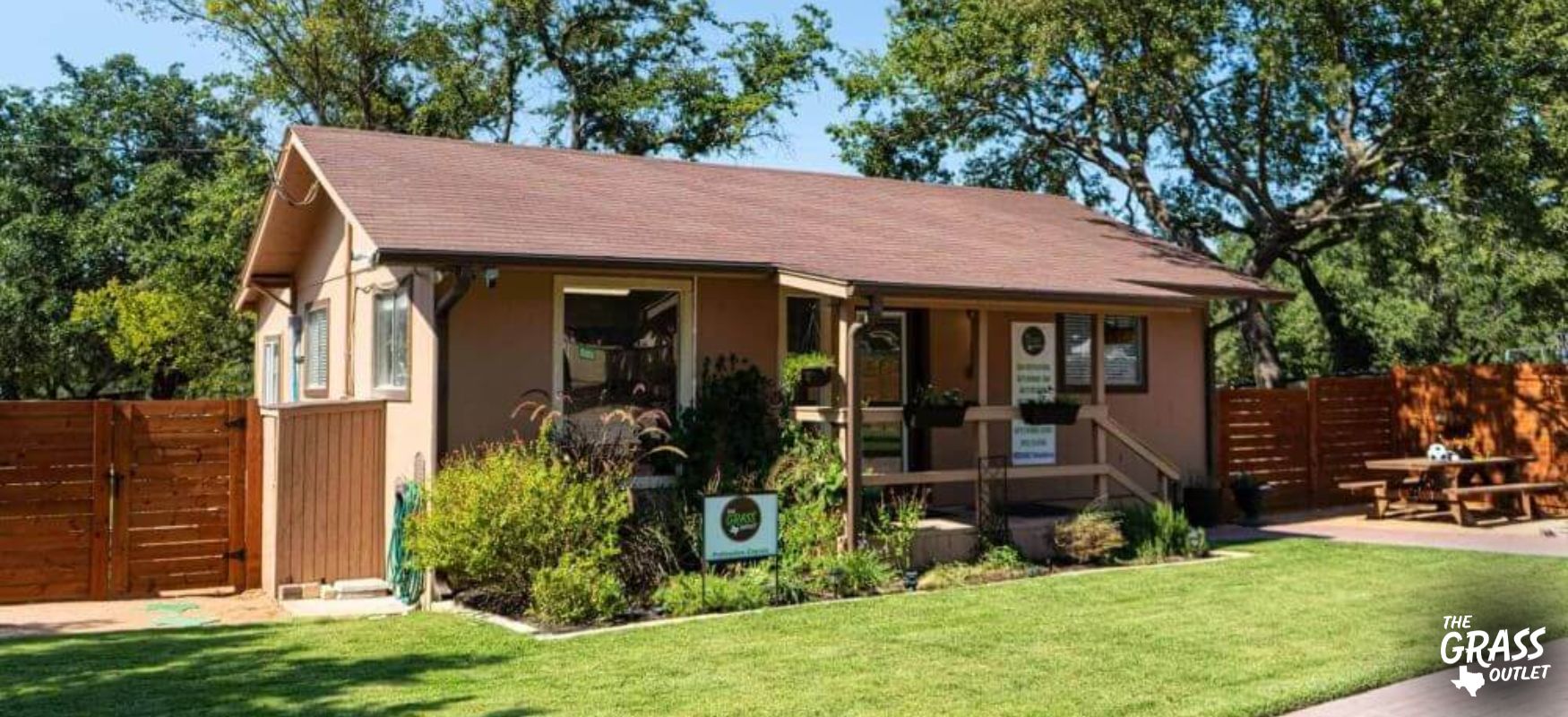
Keep the grass at an appropriate height, which for most grass types in Texas is about 2 to 3 inches. Avoid cutting more than one-third of the grass height at once to prevent stress and disease. Test the soil to understand its nutritional needs.
Fertilize accordingly, usually once in spring and once in autumn, using a fertilizer suitable for your grass type and soil condition.
Aerating the lawn helps improve water and nutrient penetration. Dethatching removes dead grass and debris that can block water and nutrients from reaching the soil.
Address lawn weeds, as they compete with grass for nutrients and water. Use pre-emergent herbicides to prevent weed seeds from germinating and post-emergent herbicides for existing weeds.
Regarding the aesthetics of the lawn, creating patterns gives it a particular dynamic and unique aesthetic that is pleasing to the eye. You can experiment and change patterns to find the one that best suits your style and grass height. Choose the pattern before you start mowing.
Common choices include stripes, checkerboard patterns, diamond patterns, waves, concentric circles, and zig-zag formations for those who want a unique dynamic on the ground.
Utilizing Potted Plants and Containers
In addition to the flowers planted in certain parts of the lawn or near paths, you can express your creativity by growing flowers in pots, especially those that withstand the Texas climate and do not require much effort to maintain.
Potted flowers and plants significantly contribute to the overall aesthetics of your yard, adding liveliness and a personal touch. You can place pots in multiple spots in the yard to achieve playfulness, or you can dedicate a specific corner and place pots in the colors and materials of your choice. It’s up to you to express your creativity. Caring for potted plants is often easier than caring for an entire garden.
Pots allow you to grow a wide range of plants that may not suit your garden’s soil type or climatic conditions. Also, this is an opportunity to experiment with different combinations of plants and pot designs. The presence of plants reduces stress and improves mood, making pots with plants a great addition indoors and outdoors due to their calming effect. Bring them inside during the winter to preserve their health and care for them properly.
We suggest plants like cacti, succulents, lantana, bougainvillea, Salvia, Geraniums, Texas Sage, Hibiscus, Meditereanean herbs, etc.
Creating rock gardens in open spaces is a way to enrich your yard and make a unique dynamic and aesthetic. These gardens are an excellent way to separate certain parts of the yard or place them in a specific corner. Rocks withstand heat well. Choose local stones to achieve a natural look; for authenticity, you can select stones of various shapes and colors.
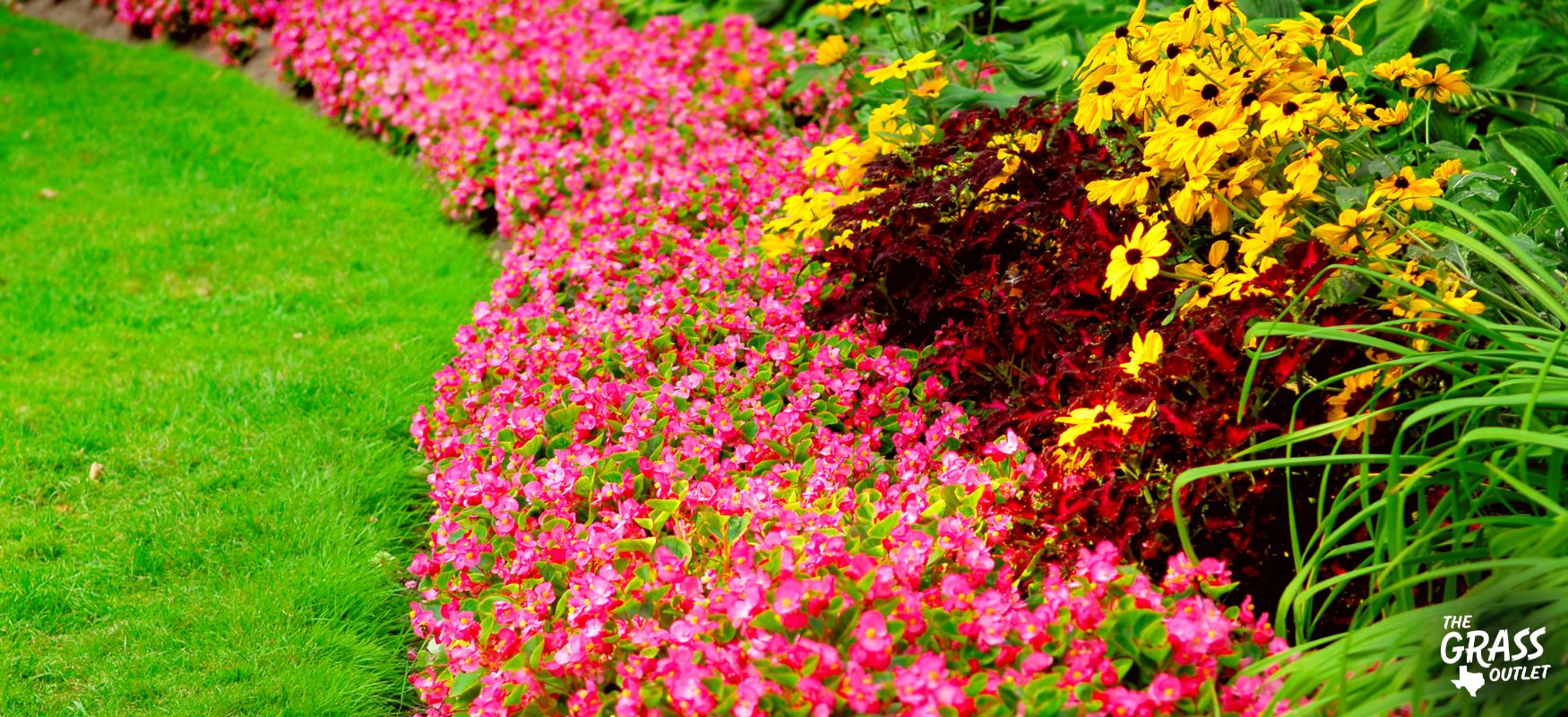
Landscape Lighting for Ambiance and Safety
We know that yards are most attractive during the day when all the colors and vibrations come to the forefront. Still, it’s important to remember what they need during the nighttime hours. Smartly chosen lighting will be functional, aesthetically attractive, and enchanting, creating a cozy atmosphere. The main idea is to form an intimate, gentle space conducive to relaxation and pleasant gatherings.
Defining which parts of the yard you want to illuminate is necessary. Still, people usually combine lighting of the seating area, kitchen and grill area, certain points on the walls, and specific plants with lighting along the edge of the paths. Also, if you have a pool, set up lighting around it to highlight it during the night. It’s essential to illuminate stairs and trails to prevent falls and injuries. Think ecologically and choose energy-efficient lighting.
Safety is no less important, so ensuring the correctness of installations and all connections is vital. Besides, it’s essential that outdoor lighting is resistant to harsh weather conditions, primarily rain. Use Ground Fault Circuit Interrupter (GFCI) outlets for outdoor lighting to protect against electric shock.
Integrating Art and Decorative Elements
Backyards are also places where you can express your creativity and leave a personal touch. The artistic elements you incorporate depend on your style and sensibilities – some prefer minimalism and simplicity. In contrast, others aim for an explosion of colors and styles through unique decorative elements.
Include sculptures of various sizes and materials throughout the yard. These can range from abstract metal pieces to classic stone statues. Place them among plants, beside ponds, or as a central element in the seating area.
Use fences or walls for murals depicting nature, or you can hang climbing plants like vines. Walls or fences can also create a mosaic of pots in various colors. Garage walls can also serve as a base for a mural.
Install a fountain or pond with artistic elements such as sculptural fountains, decorative stones, or artistically designed basins.
Use lamps to light paths, highlight plants, or create a rustic ambiance. Lanterns, spare strings, or even customized soft sculptures can lend an incredibly relaxed touch to the evening atmosphere.
Consider pieces encouraging interaction, like a garden maze or a kinetic wind sculpture.
As the seasons change, you can create thematic decorations – autumn wreaths of leaves, winter ice sculptures, or spring floral arrangements.
These artistic and creative elements add personality to your yard, creating a dynamic and inviting outdoor space for all seasons and occasions.
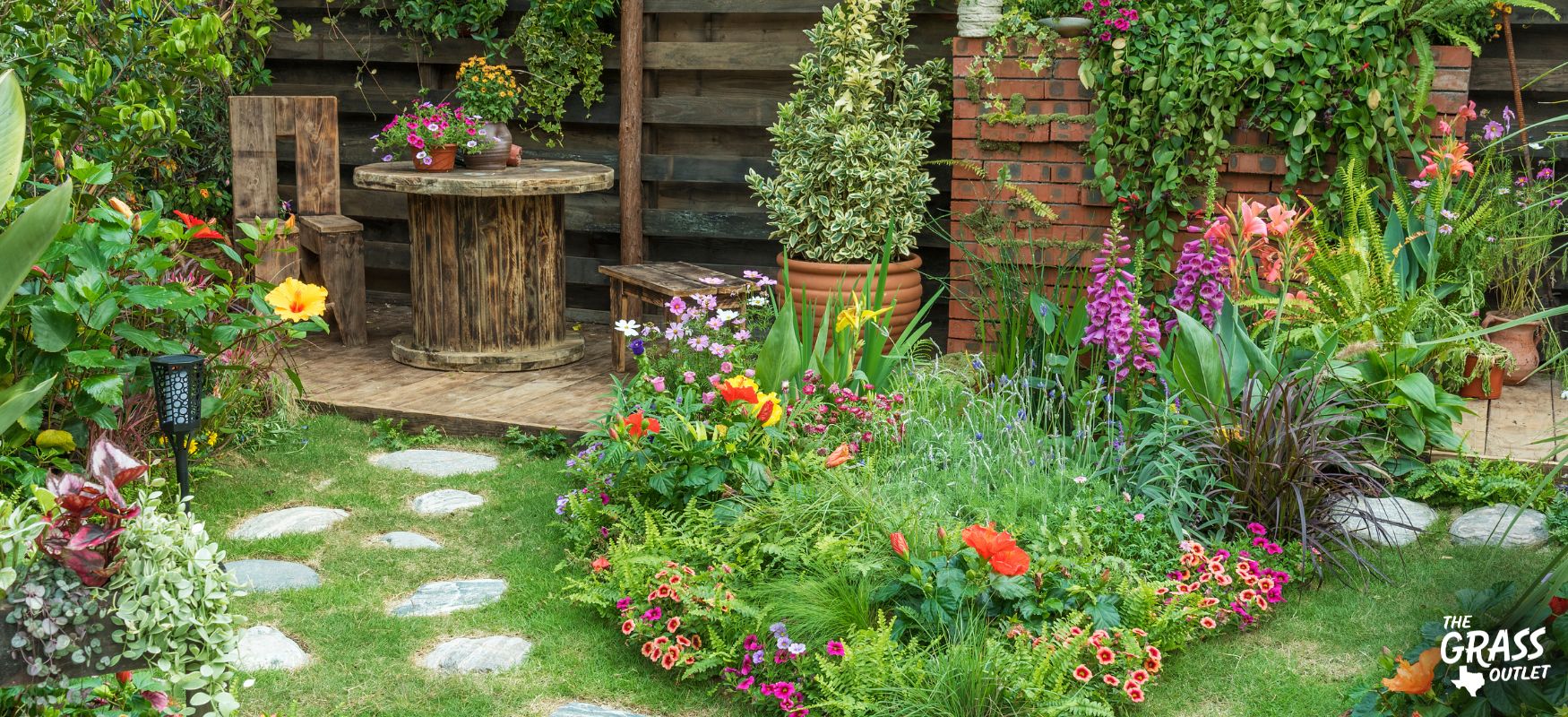
Conclusion
A backyard is inspirational, inviting you to incorporate all the elements you wish to enhance the outdoor space, thus creating a place for relaxation and enjoyment. From the choice of plants, grass varieties, rock gardens, decorative and practical elements, garden furniture, and interesting paths to ambient lighting – a backyard can truly reflect your creativity and style.
Certainly, before any landscaping action, define your style and necessary elements, measure the space to know where to position the seating area, perhaps pools or ponds, choose plants for pots, select materials for paths, and choose adequate lighting.
Let your imagination run free, and you’ll see how quickly you can enjoy what you’ve created yourself. If you have doubts, you can consult local experts to facilitate decision-making.





